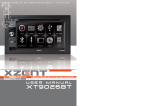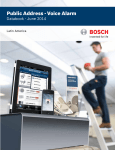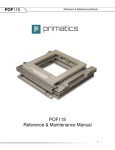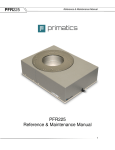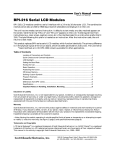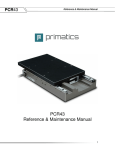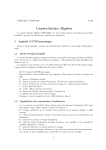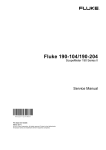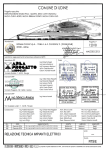Download Bosch CS 150 RC Instruction manual
Transcript
sch Praesideo PRS-CSM / PRS-CSRM / PRS-CSKPM Digital Public Address and Emergency Sound System en Installation and User Instructions Praesideo PRS-CSM / PRS-CSRM / PRS-CSKPM en | 2 Disclaimer NOTE: Although every effort has been made to ensure the information and data contained in these Installation and User Instructions is correct, no rights can be derived from the contents. Bosch Security Systems disclaim all warranties with regard to the information provided in these instructions. In no event shall Bosch Security Systems be liable for any special, indirect or consequential damages whatsoever resulting from loss of use, data or profits, whether in action of contract, negligence or other tortious action, arising out of or in connection with the use of the information provided in these Installation and User Instructions. Important Safeguards Prior to installing or operating this product, always read the Important Safety Instructions which are available as a separate document and are packed with all units that can be connected to the mains. FCC Requirements Class A All Praesideo devices are verified to comply according 47 CFR subpart 15 B, Unintentional Radiators. Class A Digital device, peripherals and external switching power supplies. (Pb) X X X O X X O: (Hg) O O O O O O (Cd) O X X O X X This equipment has been tested and found to comply with the limits for a Class A digital device, pursuant to Part 15 of the FCC Rules. These limits are designed to provide reasonable protection against harmful interference when the equipment is operated in a commercial environment. This equipment generates, uses, and can radiate radio frequency energy and, if not installed and used in accordance with the instruction manual, may cause harmful interference to radio communications. Operation of this equipment in a residential area is likely to cause harmful interference in which case the user will be required to correct the interference at his own expense. FCC Notice This device complies with Part 15 of the FCC Rules. Operation is subject to the following two conditions: 1. This device may not cause harmful interference, and 2. This device must accept any interference received, including interference that may cause undesired operation. Modifications Any modifications made to this device that are not approved by the manufacturer may void the authority granted to the user by the FCC to operate this equipment. Canada This Class A digital apparatus complies with Canadian ICES-003. Cet appareil numérique de la classe A est conforme à la norme NMB-003 du Canada. (Cr6+) O X X O X X SJ/T11363-2006 X: Bosch Security Systems B.V. (PBB's) O X O X O O SJ/T11363-2006 Installation and User Instructions (PBDE's) O X O X O O . . IUI PRS-CS(R)(KP)M | V1.0 | 2013.12 Praesideo PRS-CSM / PRS-CSRM / PRS-CSKPM en | 3 Table of Contents 1 PRS-CSM Call Station Module ......................................................................................................................5 1.1 Introduction ...............................................................................................................................................................5 1.2 Controls, connectors and indicators .......................................................................................................................6 1.2.1 Back-up supply/Buzzer (1) ..................................................................................................................................7 1.2.2 Microphone/PTT key connection (2) ................................................................................................................7 1.2.3 Loudspeaker/Control Inputs (3) ........................................................................................................................8 1.2.4 Headset/Volume control (4) ...............................................................................................................................8 1.2.5 Control input/outputs (5, 6) ................................................................................................................................9 1.2.6 Keypad interface (X143) ...................................................................................................................................11 1.3 Installation ...............................................................................................................................................................12 1.4 Technical Data ........................................................................................................................................................13 1.4.1 Physical characteristics ......................................................................................................................................13 1.4.2 Climate conditions .............................................................................................................................................13 1.4.3 EMC and Safety .................................................................................................................................................13 1.4.4 Mean time between failures ............................................................................................................................13 1.4.5 System bus ..........................................................................................................................................................13 1.4.6 Backup power supply ........................................................................................................................................13 1.4.7 Microphone ........................................................................................................................................................13 1.4.8 Loudspeaker .......................................................................................................................................................13 1.4.9 Headset ...............................................................................................................................................................14 1.4.10 Controls ............................................................................................................................................................14 1.4.11 Buzzer ................................................................................................................................................................14 2 PRS-CSRM Remote Call Station Module .................................................................................................15 2.1 Introduction .............................................................................................................................................................15 2.2 Controls, connectors and indicators .....................................................................................................................16 2.2.1 Back-up supply/Buzzer (1) ................................................................................................................................17 2.2.2 Microphone/PTT key connection (2) ..............................................................................................................17 2.2.3 Loudspeaker/Control inputs (3) .......................................................................................................................17 2.2.4 Headset/Volume control (4) .............................................................................................................................18 2.2.5 Control input/outputs (5, 6) ..............................................................................................................................19 2.2.6 Keypad interface (X1) .......................................................................................................................................21 2.3 Installation ...............................................................................................................................................................22 2.4 Technical Data ........................................................................................................................................................23 2.4.1 Physical characteristics ......................................................................................................................................23 2.4.2 Climate conditions .............................................................................................................................................23 2.4.3 Electromagnetic compatibility ..........................................................................................................................23 2.4.4 Mean time between failures ............................................................................................................................23 2.4.5 Call station interface ..........................................................................................................................................23 2.4.6 Backup power supply ........................................................................................................................................23 2.4.7 Microphone ........................................................................................................................................................23 2.4.8 Loudspeaker .......................................................................................................................................................23 2.4.9 Headset ...............................................................................................................................................................24 2.4.10 Controls ............................................................................................................................................................24 2.4.11 Buzzer ................................................................................................................................................................24 3 PRS-CSKPM Call Station Keypad Module ..............................................................................................25 3.1 Introduction .............................................................................................................................................................25 Bosch Security Systems B.V. Installation and User Instructions IUI PRS-CS(R)(KP)M | V1.0 | 2013.12 Praesideo PRS-CSM / PRS-CSRM / PRS-CSKPM en | 4 3.2 Controls, connectors and indicators .....................................................................................................................26 3.2.1 Key inputs (1) .....................................................................................................................................................27 3.2.2 Control outputs (2) ............................................................................................................................................27 3.2.3 Keypad interface (X5, X6) ................................................................................................................................28 3.2.4 ID selector (S9) ..................................................................................................................................................29 3.3 Installation ...............................................................................................................................................................30 3.3.1 Connecting the PRS-CSKPM to other modules ............................................................................................31 3.4 Technical data .........................................................................................................................................................32 3.4.1 Physical characteristics ......................................................................................................................................32 3.4.2 Climate conditions ...........................................................................................................................................32 3.4.3 EMC and Safety .................................................................................................................................................32 3.4.4 Mean time between failures ............................................................................................................................32 3.4.5 System bus ..........................................................................................................................................................32 Bosch Security Systems B.V. Installation and User Instructions IUI PRS-CS(R)(KP)M | V1.0 | 2013.12 Praesideo PRS-CSM / PRS-CSRM / PRS-CSKPM 1 en | 5 PRS-CSM Call Station Module 1.1 Introduction The PRS-CSM Call Station Module can be used to make custom-made call stations (e.g. an emergency call station). The module uses a built-in limiter and speech filter for improved intelligibility. The module has a metal housing for easy mounting and stacking in cabinets, and screw connectors for easy interconnection to microphone, loudspeaker, switch and indicators. See figure 1.1 for a block diagram of the call station module. Headset Keypad Keypad (max. 16) Loudspeaker Microphone A/D Network Processor + DSP PTT Control Inputs D/A I Volume Power O Fault Call Status POF POF Emergency Network Redundancy Switching System Fault Buzzer figure 1.1: Block diagram PRS-CSM Bosch Security Systems B.V. Installation and User Instructions IUI PRS-CS(R)(KP)M | V1.0 | 2013.12 Praesideo PRS-CSM / PRS-CSRM / PRS-CSKPM 1.2 en | 6 Controls, connectors and indicators The call station module contains the following connections (see figure 1.2 and figure 1.3): 1 Back-up supply/Buzzer - Besides powering the call station module via the system network connector (7), it can also be powered externally from a back-up power supply via this connector (see section 1.2.1). On this connector also a buzzer can be connected. 2 Microphone/PTT key - The microphone input is used to connect a microphone and a PressTo-Talk (PTT) switch (see section 1.2.2). 3 Loudspeaker/Control Inputs - The loudspeaker is meant for listening to chimes, pre-recorded messages and alarms (see section 1.2.3) activated by a PTT key of the call station or one of its keypads (see section 47.3.3 of the IUI Praesideo 4.0). This connector also provides 1 2 4 5, 6 7 two control inputs, e.g. to accept fault outputs from a backup power supply. Headset/Volume control potentiometer - This connector provides the possibility to connect a headset and a volume control potentiometer to the call station module (see section 1.2.4).This potentiometer also controls the volume of a loudspeaker connected to 3. Control input/outputs - The control input and five control outputs on these two connectors act in a similar way as the PTT key and LEDs on the LBB4430/00 Call Station Basic (see section 1.2.5). System bus - Two system bus connectors to connect the call station module to other Praesideo equipment. Both connectors are interchangeable. 3 4 5 6 24V Buzz Mic PTT Lsp CI 1 CI 2 Hmic Vol Hlsp PTT Pwr Fault Syst Call Emg Fault 1 2 3 4 1 2 3 4 5 6 1 2 3 4 5 6 1 2 3 4 5 6 1 2 3 4 5 6 7 8 9 10 11 12 + + figure 1.2: PRS-CSM installer front view Note All cables connected to 1 to 6 must be less than 3 meter in length. 7 Network 1 48V 2 48V figure 1.3: PRS-CSM system front view Bosch Security Systems B.V. Installation and User Instructions IUI PRS-CS(R)(KP)M | V1.0 | 2013.12 Praesideo PRS-CSM / PRS-CSRM / PRS-CSKPM 1.2.1 en | 7 Back-up supply/Buzzer (1) This 4-pin connector provides the input for a backup power supply and a buzzer. Typically a 24V supply is used, but a voltage in the range 18..56V is allowed. A buzzer can be connected here for fault and alarm notification. A low voltage type buzzer must be used that can operate on 3V. Suitable models are the Mallory PK-20A35EWQ or Alan Butcher Components ABI-004RC. table 1.1: Back-up supply/buzzer connector details Pin Signal 1 Back-up supply (+) 2 Back-up supply (GND) 3 Buzzer (+) 4 Buzzer (-) 1.2.2 Microphone/PTT key connection (2) This 6-pin connector provides the connection for a microphone and a PTT key. The following dynamic microphones are suited for use with the module: • LBB9081 Hand-held Dynamic Microphone (including resistors for switch supervision). • LBB9082 Gooseneck Dynamic Microphone. table 1.2: Microphone/PTT key connector details Pin Signal 1 Mic + 2 GND 3 Mic 4 --- not connected --5 PTT input contact 6 GND 10k: red white black 1 3 2 figure 1.5: LBB9082 connection diagram For the selection of the microphone type, a jumper on X149/X150 is used. To get access to this jumper, remove the top cover (see also section 3.3). For the location of X149 and X150 on the PCB see figure 1.13. Jumper settings: 1 2 3 Microphone selection via configuration webpage 1 2 1 2 3 Dynamic microphone 1 2 1 2 3 Electret microphone 1 blue 5 black 6 red 1 white 3 2 10k: black (thick) 2 figure 1.4: LBB9081 connection diagram Bosch Security Systems B.V. Installation and User Instructions IUI PRS-CS(R)(KP)M | V1.0 | 2013.12 Praesideo PRS-CSM / PRS-CSRM / PRS-CSKPM 1.2.3 en | 8 Loudspeaker/Control Inputs (3) This 6-pin connector provides the connection to a loudspeaker and to two control inputs. table 1.3: Loudspeaker/ Control Input connector details Pin Signal 1 Speaker + 2 Speaker 3 Control input 1 4 Return control input 1 5 Control input 2 6 Return control input 2 The control inputs can be configured to act on contact make or on contact break (see section 43.4.7 of the IUI Praesidio 4.0). It is also possible to supervise the cables for short-circuits and open connections (see figure 1.6 and figure 1.7). Whether a control input is actually supervised or not is defined in the configuration. RTN Control input 10k: 10k: figure 1.6: Supervised control input RTN Control input Warning Do not connect DC or AC signals to the control inputs, otherwise the input circuit may be damaged. Only use voltage-free contacts. Note Do not combine control input wires of multiple control inputs (e.g. do not use a common return wire). 1.2.4 Headset/Volume control (4) This 6-pin connector provides the connection to the headset and the volume control. This volume control also controls the volume of the loudspeaker connected to connection 3. A linear potentionmeter R (typical value: 100 kohm) is used to create a control voltage from the supply voltage. If a volume control is not needed, pin 2 and 3 must be connected to each other. The volume level of the earphone or loudspeaker is then at its maximum. table 1.4: Headset/Volume Control connector details Pin Signal 1 Headset (mic +) 2 GND (mic -) 3 Volume control voltage 4 3.3 V supply output 5 GND (earphone -) 6 Earphone + 1 Microphone 2 3 R Volume Headset 4 5 Earphone figure 1.7: Non-supervised control input 6 figure 1.8: Headset connection diagram Bosch Security Systems B.V. Installation and User Instructions IUI PRS-CS(R)(KP)M | V1.0 | 2013.12 Praesideo PRS-CSM / PRS-CSRM / PRS-CSKPM 1.2.5 en | 9 Control input/outputs (5, 6) These two 6-pin connectors provide the connection of one control input for the PTT key and five control outputs for indicator LEDs. Warning Do not connect DC or AC signals to the control inputs, otherwise the input circuit may be damaged. Only use voltage-free contacts. table 1.5: Control inputs/outputs connector details Pin Signal 1 PTT input contact 2 GND 3 LED Power Indicator +/anode 4 LED Power Indicator -/cathode 5 LED Fault Indicator +/anode 6 LED Fault Indicator -/cathode 7 LED Call Status Indicator +/anode 8 LED Call Status Indicator -/cathode 9 LED Emergency Indicator +/anode 10 LED Emergency Indicator -/cathode 11 LED System Fault Indicator +/anode 12 LED System Fault Indicator -/cathode PTT Input Contact 10 kΩ 5V 10 kΩ 10 kΩ GND figure 1.9: Press-to-talk (PTT) key The PTT input contact on this connector is in parallel with the PTT input contact on connector 2. Use only one of them. See figure 1.9 for a connection diagram. The two resistors must be placed in the circuit, because the contact is always supervised by the system software. In figure 1.10 the LED driver circuit is shown. Typical colors for the indicator LEDs are: • Green for power and call status indicators; • Yellow for fault and system fault indicators; • Red for the emergency indicator. +5V, 30 mA 330: 330: 3 Pwr 11 Emg 8 62V 330: 9 Call 6 62V 330: 7 Fault 4 62V 330: 5 Syst fault 10 62V 12 62V figure 1.10: Internally powered LEDs Pwr: Power indicator Fault: Fault indicator Call: Call status indicator Emg: Emergency indicator Syst Fault: System fault indicator Bosch Security Systems B.V. Installation and User Instructions IUI PRS-CS(R)(KP)M | V1.0 | 2013.12 Praesideo PRS-CSM / PRS-CSRM / PRS-CSKPM en | 10 It is also possible to connect an externally powered lamp or LED (see figure 1.11), or an externally powered relay (see figure 1.12). Use pin 2 of connector 5 as GND. I < 100 mA R Max. 56V LED indicator -/cathode GND figure 1.11: Externally powered LED The value of resistor R in figure 1.10 depends on the voltage of the external source, the forward voltage of the LED and the current flowing through the LED: Vsource – Vforward R = --------------------------------------------I For example, the voltage of the external source is 24 V, the forward voltage of the LED is 2 V and the current flowing through the LED is 10 mA, then: 24 – 2 R = -------------------= 2200 ( Ω ) –3 10 ⋅ 10 I < 100 mA Max. 56V LED indicator -/cathode GND figure 1.12: Externally powered relay Bosch Security Systems B.V. Installation and User Instructions IUI PRS-CS(R)(KP)M | V1.0 | 2013.12 Praesideo PRS-CSM / PRS-CSRM / PRS-CSKPM 1.2.6 en | 11 Keypad interface (X143) Additional keypads or keypad modules can be connected to this call station module via a 16-postion flatcable, connected to X143. This flatcable is supplied with each keypad or keypad module. Up to 16 keypads and/or keypad modules can be connected in series (loop through). See also section 3.3 X143 1. 2. . . . . . . . . . . . . 15 16 . X149 1 3 X150 1 2 figure 1.13: Component side PCB of the PRS-CSM Bosch Security Systems B.V. Installation and User Instructions IUI PRS-CS(R)(KP)M | V1.0 | 2013.12 Praesideo PRS-CSM / PRS-CSRM / PRS-CSKPM 1.3 en | 12 Installation The call station module is fitted with brackets and screw holes for easy installation. See figure 1.14. Make sure to leave enough space for the cables and the connectors. Especially the minimum bend radius of the Praesideo network cables must be observed (see section 31.6 of the IUI Praesidio 4.0). 183 4.2 19.2 38.4 174 * * 37 90 164 162 174 42.6 figure 1.14: PRS-CSM installation dimensions *: the exact layout depends on the module type Bosch Security Systems B.V. Installation and User Instructions IUI PRS-CS(R)(KP)M | V1.0 | 2013.12 Praesideo PRS-CSM / PRS-CSRM / PRS-CSKPM en | 13 1.4 Technical Data 1.4.1 Physical characteristics 1.4.6 Dimensions (H x W x D): 43 x 183 x 164 mm Weight: 0.8 kg 1.4.2 EMC and Safety Electromagnetic compatibility: EN55103-1/FCC-47 part 15B EN55103-2 EN50121-4 EN50130-4 Electrical safety: IEC60065 (CB-scheme) EN60065 Approvals: CE marking EN60849, EN54-16 and ISO7240-16 IEC60945 1.4.4 Microphone Microphone input sensitivity: -55 dBV (balanced) Input control range: -7 to 8 dB S/N: min. 60 dB at rated sensitivity Headroom: min. 30 dB at rated sensitivity Bandwidth: 340 to 14000 Hz (-3 dB ref. 1 kHz) Supervision limits: 180 to 14000 ohm (dynamic microphone) 0.2 to 4.8 mA (electret microphone) Temperature: -5 to +55 °C (operating, guaranteed) -15 to +55 °C (operating, sample tested) -20 to +70 °C (non-operating) Relative humidity: 15 to 90%, non-condensing (operating) 5 to 95%, non-condensing (non-operating) Air pressure: 600 to 1100 hPa 1.4.3 Backup voltage: 18 to 56 V(DC) No fault reporting when > 20 V Backup current: max. 2 A (with maximum number of keypads) 1.4.7 Climate conditions Backup power supply 1.4.8 Loudspeaker Impedance: 8 to 32 ohm Signal/Noise ratio: typical 80 dB ± 3 dB at max. output Output power: typical 100 mW, max. 300 mW Mean time between failures Expected lifetime: 50,000 hours at +55 °C MTBF: 500,000 hours (based on real warranty return rate data) 1.4.5 System bus Power supply via network: 18 to 56V (DC) No fault reporting when >20V Network power consumption: 6.2 W (excluding keypads) Bosch Security Systems B.V. Installation and User Instructions IUI PRS-CS(R)(KP)M | V1.0 | 2013.12 Praesideo PRS-CSM / PRS-CSRM / PRS-CSKPM 1.4.9 en | 14 Headset 1.4.10 Mic. input sensitivity: -44 dBV Input sensitivity control range: -7 to 8 dB Microphone current for headset detection: 0.15 to 0.8 mA Signal/Noise: 60 dB at rated sensitivity (microphone) 80 dB (earphone) Earphone impedance: min. 16 ohm (typical 32 W) Crosstalk (earphone to microphone): max. -40 dB Bandwidth: 340 to 14000 Hz (-3dB ref. 1 kHz) Output power: 0.1 to 30 mW (typical 1 mW) Volume control voltage: 0 to 3.3 V Controls Loudspeaker and headset volume Volume control voltage: 0 to 3.3 V Control input 1, 2 and PTT input contact Resistance detection (supervision enabled): Cable short circuit < 2.5 kohm Contact closed 7.5 kohm to12 kohm Contact open 17.5 kohm to 22 kohm Cable broken > 27 kohm Resistance detection (supervision disabled): Contact closed < 12 kohm Contact open > 17.5 kohm Control outputs Output type: open collector/drain Internal output supply current: max. 10 mA (per pin) max. 30 mA (in total max. 3 LEDs are simultaneously on) Output voltage: max. 56 V (per pin) Output sink current: max. 100 mA per output switch pin 1.4.11 Buzzer Buzzer voltage: 3.3V Bosch Security Systems B.V. Installation and User Instructions IUI PRS-CS(R)(KP)M | V1.0 | 2013.12 Praesideo PRS-CSM / PRS-CSRM / PRS-CSKPM 2 en | 15 PRS-CSRM Remote Call Station Module 2.1 Introduction The PRS-CSRM Remote Call Station Module can be used to make custom-made remote call stations (e.g. a remote emergency call station). The module uses a built-in limiter and speech filter for improved intelligibillity. The module has a metal housing for easy mounting and stacking in cabinets, and screw connectors for easy interconnection to microphone, loudspeaker, switch and indicators. See figure 2.1 for a block diagram of the remote call station module. Headset Keypad Keypad (max. 16) Loudspeaker Microphone A/D Network Processor + DSP PTT Control Inputs D/A I Volume Power O Fault Call Status Emergency Cat-5 Network Redundancy Switching System Fault Buzzer figure 2.1: Block diagram PRS-CSRM Bosch Security Systems B.V. Installation and User Instructions IUI PRS-CS(R)(KP)M | V1.0 | 2013.12 Praesideo PRS-CSM / PRS-CSRM / PRS-CSKPM 2.2 en | 16 Controls, connectors and indicators The remote call station module contains the following connections (see figure 2.2 and figure 2.3): 1 Back-up supply/Buzzer - Besides powering the call station module via the system network connector (7), it can also be powered externally from a back-up power supply via this connector (see section 2.2.1). On this connector also a buzzer can be connected. 2 Microphone/PTT key - The microphone input is used to connect a microphone and a PressTo-Talk (PTT) switch (see section 2.2.2) 3 Loudspeaker/Control Inputs - The loudspeaker is meant for listening to chimes, pre-recorded messages and alarms (see section 2.2.3) activated by a PTT key of the call station or one of its keypads (see section 47.3.3 of the IUI Praesideo 4.0). This connector also provides 1 2 4 5, 6 7 8 two control inputs, e.g. to accept fault outputs from a backup power supply. Headset/Volume control potentiometer - This connector provides the possibility to connect a headset and a volume control potentiometer to the call station module (see section 2.2.4).This potentiometer also controls the volume of a loudspeaker connected to 3. Control input/outputs - The control input and five control outputs on these two connectors act in a similar way as the PTT key and LEDs on the LBB4430/00 Call Station Basic (see section 2.2.5). PRS-CSI connection - An RJ45 connector to connect the remote call station module to a call station interface via a straight Cat-5 cable. Factory test connector. 3 4 5 6 24V Buzz Mic PTT Lsp CI 1 CI 2 Hmic Vol Hlsp PTT Pwr Fault Syst Call Emg Fault 1 2 3 4 1 2 3 4 5 6 1 2 3 4 5 6 1 2 3 4 5 6 1 2 3 4 5 6 7 8 9 10 11 12 + + figure 2.2: PRS-CSRM installer front view Caution Do not connect the connector 7 to any Telecom or Ethernet network. This connection is dedicated for PRS-CSI only. Note All cables connected to 1 to 6 must be less than 3 meter in length. 8 Service 7 CSI 48V figure 2.3: PRS-CSRM system front view Bosch Security Systems B.V. Installation and User Instructions IUI PRS-CS(R)(KP)M | V1.0 | 2013.12 Praesideo PRS-CSM / PRS-CSRM / PRS-CSKPM 2.2.1 en | 17 Back-up supply/Buzzer (1) This 4-pin connector provides the input for a backup power supply and a buzzer. Typically a 24V supply is used, but a voltage in the range 18..56V is allowed. A buzzer can be connected here for fault and alarm notification. A low voltage type buzzer must be used that can operate on 3V. Suitable models are the Mallory PK-20A35EWQ or Alan Butcher Components ABI-004RC. table 2.1: Back-up supply/buzzer connector details Pin Signal 1 Back-up supply (+) 2 Back-up supply (GND) 3 Buzzer (+) 4 Buzzer (-) 2.2.2 Microphone/PTT key connection (2) This 6-pin connector provides the connection for a microphone and a PTT key. The following dynamic microphones are suited for use with the module: • LBB9081 Hand-held Dynamic Microphone (including resistors for switch supervision). • LBB9082 Gooseneck Dynamic Microphone. red white black 1 3 2 figure 2.5: LBB9082 connection diagram For the selection of the microphone type, a jumper on X300 is used. To get access to this jumper, remove the top cover (see also section 3.3). For the location of X300 on the PCB see section 2.2.6. Jumper settings: 1 2 3 Dynamic microphone 1 2 3 Electret microphone table 2.2: Microphone/PTT key connector details Pin Signal 1 Mic + 2 GND 3 Mic 4 --- not connected --5 PTT input contact 6 GND 10k: 2.2.3 blue 5 black 6 red 1 white 3 10k: black (thick) Loudspeaker/Control inputs (3) This 6-pin connector provides the connection to a loudspeaker and to two control inputs. 2 table 2.3: Loudspeaker/ Control Input connector details Pin Signal 1 Speaker + 2 Speaker 3 Control input 1 4 Return control input 5 Control input 2 6 Return control input The control inputs can be configured to act on contact make or on contact break (see section 43.4.7 of the IUI Praesideo 4.0). It is also possible to supervise the cables for short-circuits and open connections (see figure 2.6 and figure 2.7). Whether a control input is actually supervised or not, is defined in the configuration. figure 2.4: LBB9081 connection diagram Bosch Security Systems B.V. Installation and User Instructions IUI PRS-CS(R)(KP)M | V1.0 | 2013.12 Praesideo PRS-CSM / PRS-CSRM / PRS-CSKPM en | 18 2.2.4 RTN This 6-pin connector provides the connection to the headset and the volume control. This volume control also controls the volume of the loudspeaker connected to connection 3. A logarithmic potentionmeter R (typical value: 100 kohm) is used to attenuate the audio signal. If a volume control is not needed, pin 3 and 4 must be connected to each other. The volume level of the earphone or loudspeaker is then at its maximum. Control input 10k: table 2.4: Headset/Volume Control connector details Pin Signal 1 Headset (mic +) 2 GND (mic -) 3 Audio-in from volume control 4 Audio-out to volume control 5 GND (earphone -) 6 Earphone + 10k: figure 2.6: Supervised control input RTN Headset/Volume control (4) Control input 1 Microphone 2 3 R Volume Headset 4 5 Earphone figure 2.7: Non-supervised control input 6 Warning Do not connect DC or AC signals to the control inputs, otherwise the input circuit may be damaged. Only use voltage-free contacts. figure 2.8: Headset connection diagram Note Do not combine control input wires of multiple control inputs (e.g. do not use a common return wire). Bosch Security Systems B.V. Installation and User Instructions IUI PRS-CS(R)(KP)M | V1.0 | 2013.12 Praesideo PRS-CSM / PRS-CSRM / PRS-CSKPM 2.2.5 en | 19 Control input/outputs (5, 6) These two 6-pin connectors provide the connection of one control input for the PTT key and five control outputs for indicator LEDs. Warning Do not connect DC or AC signals to the control inputs, otherwise the input circuit may be damaged. Only use voltage-free contacts. table 2.5: Control inputs/outputs connector details Pin Signal 1 PTT input contact 2 GND 3 LED Power Indicator +/anode 4 LED Power Indicator -/cathode 5 LED Fault Indicator +/anode 6 LED Fault Indicator -/cathode 7 LED Call Status Indicator +/anode 8 LED Call Status Indicator -/cathode 9 LED Emergency Indicator +/anode 10 LED Emergency Indicator -/cathode 11 LED System Fault Indicator +/anode 12 LED System Fault Indicator -/cathode PTT Input Contact 10 kΩ 5V 10 kΩ 10 kΩ GND figure 2.9: Press-to-talk (PTT) key The PTT input contact on this connector is in parallel with the PTT input contact on connector 2. Use only one of them. See figure 2.9 for a connection diagram. The two resistors must be placed in the circuit, because the contact is always supervised by the system software. In figure 2.10 the LED driver circuit is shown. Typical colors for the indicator LEDs are: • Green for power and call status indicators; • Yellow for fault and system fault indicators; • Red for the emergency indicator. +5V, 30 mA 330: 330: 3 Pwr 11 Emg 8 62V 330: 9 Call 6 62V 330: 7 Fault 4 62V 330: 5 Syst fault 10 62V 12 62V figure 2.10: Internally powered LEDs Pwr: Power indicator Fault: Fault indicator Call: Call status indicator Emg: Emergency indicator Syst Fault: System fault indicator Bosch Security Systems B.V. Installation and User Instructions IUI PRS-CS(R)(KP)M | V1.0 | 2013.12 Praesideo PRS-CSM / PRS-CSRM / PRS-CSKPM en | 20 It is also possible to connect an externally powered lamp or LED (see figure 2.11), or an externally powered relay (see figure 2.12). Use pin 2 of connector 5 as GND. I < 100 mA R Max. 56V LED indicator -/cathode GND figure 2.11: Externally powered LED The value of resistor R in figure 2.10 depends on the voltage of the external source, the forward voltage of the LED and the current flowing through the LED: Vsource – Vforward R = --------------------------------------------I For example, the voltage of the external source is 24 V, the forward voltage of the LED is 2 V and the current flowing through the LED is 10 mA, then: 24 – 2 R = -------------------= 2200 ( Ω ) –3 10 ⋅ 10 I < 100 mA Max. 56V LED indicator -/cathode GND figure 2.12: Externally powered relay Bosch Security Systems B.V. Installation and User Instructions IUI PRS-CS(R)(KP)M | V1.0 | 2013.12 Praesideo PRS-CSM / PRS-CSRM / PRS-CSKPM 2.2.6 en | 21 Keypad interface (X1) Additional keypads or keypad modules can be connected to this call station module via a 16-postion flatcable, connected to X1. This flatcable is supplied with each keypad or keypad module. Up to 16 keypads and/or keypad modules can be connected in series (loop through). See also section 3.3. X1 1. 2. . . . . . . . . . . . . 15 16 . X300 1 3 figure 2.13: Component side PCB of the PRS-CSRM Bosch Security Systems B.V. Installation and User Instructions IUI PRS-CS(R)(KP)M | V1.0 | 2013.12 Praesideo PRS-CSM / PRS-CSRM / PRS-CSKPM 2.3 en | 22 Installation The remote call station module is fitted with brackets and screw holes for easy installation. See figure 2.14. Make sure to leave enough space for the cables and the connectors. 183 4.2 19.2 38.4 174 * * 37 90 164 162 174 42.6 figure 2.14: PRS-CSRM installation dimensions * the exact layout depends on module type Bosch Security Systems B.V. Installation and User Instructions IUI PRS-CS(R)(KP)M | V1.0 | 2013.12 Praesideo PRS-CSM / PRS-CSRM / PRS-CSKPM en | 23 2.4 Technical Data 2.4.1 Physical characteristics 2.4.5 Dimensions (H x W x D): 43 x 183 x 164 mm Weight: 0.8 kg 2.4.2 Climate conditions Temperature: -5 to +55 °C (operating, guaranteed) -15 to +55 °C (operating, sample tested) -20 to +70 °C (non-operating) Relative humidity: 15 to 90%, non-condensing (operating) 5 to 95%, non-condensing (non-operating) Air pressure: 600 to 1100 hPa 2.4.3 Mean time between failures Expected lifetime: 50,000 hours at +55 °C MTBF: 500,000 hours (based on real warranty return rate data) Bosch Security Systems B.V. Backup power supply Backup voltage: 18 to 56 V(DC) No fault reporting when > 20 V Backup current: max. 2 A (with maximum number of keypads) 2.4.7 Electromagnetic compatibility: EN55103-1/FCC-47 part 15B EN55103-2 EN50121-4 EN50130-4 Electrical safety: IEC60065 (CB-scheme) EN60065 Approvals: CE marking EN60849, EN54-16 and ISO7240-16 IEC60945 2.4.4 Connector: RJ45 Cable type: Cat-5 (4x twisted pair, straight) Maximum cable length: 1000 m Power supply via network: 18 to 56 V(DC) No fault reporting when >20V Network power consumption: 4 W at 48 V (excluding keypads) 2.4.6 Electromagnetic compatibility Call station interface Microphone Microphone input sensitivity: -55 dBV (balanced) Input control range: -7 to 8 dB S/N: min. 60 dB at rated sensitivity Headroom: min. 30 dB at rated sensitivity Bandwidth: 340 to 14000 Hz (-3dB ref. 1 kHz) Supervision limits: 180 to 14000 ohm (dynamic microphone) 0.2 to 4.8 mA (electret microphone) 2.4.8 Loudspeaker Impedance: 8 to 32 ohm Signal/Noise ratio: typical 80 dB ± 3 dB at max. output Output power: typical 100 mW, max. 300 mW Installation and User Instructions IUI PRS-CS(R)(KP)M | V1.0 | 2013.12 Praesideo PRS-CSM / PRS-CSRM / PRS-CSKPM 2.4.9 en | 24 Headset 2.4.10 Mic. input sensitivity: -44 dBV Input sensitivity control range: -7 to 8 dB Microphone current for headset detection: > 0.15 mA Signal/Noise: 60 dB at rated sensitivity (microphone) 80 dB (earphone) Earphone impedance: min. 16 ohm (typical 32 W) Crosstalk (earphone to microphone): max. -40 dB Bandwidth: 340 to 14000 Hz (-3dB ref. 1 kHz) Output power: 0.1 to 30 mW (typical 1 mW) Controls Loudspeaker and headset volume Volume control potentionmeter: 100 kohm logarithmic (typical) Control input 1, 2 and PTT input contact Resistance detection (supervision enabled): Cable short circuit < 2.5 kohm Contact closed 7.5 kohm to12 kohm Contact open 17.5 kohm to 22 kohm Cable broken > 27 kohm Resistance detection (supervision disabled): Contact closed < 12 kohm Contact open > 17.5 kohm Control outputs Output type: open collector/drain Internal output supply current: max. 10 mA (per pin) max. 30 mA (in total max. 3 LEDs are simultaneously on) Output voltage: max. 56 V (per pin) Output sink current: max. 100 mA per output switch pin 2.4.11 Buzzer Buzzer voltage: 3.3V Bosch Security Systems B.V. Installation and User Instructions IUI PRS-CS(R)(KP)M | V1.0 | 2013.12 Praesideo PRS-CSM / PRS-CSRM / PRS-CSKPM 3 en | 25 PRS-CSKPM Call Station Keypad Module 3.1 Introduction The PRS-CSKPM Call Station Keypad Module can be used to add keys and indicators to a custom-made call station based on the PRS-CSM (see section 1) or the PRS-SCRM (see section 2). The module has a metal housing for easy mounting and stacking in cabinets, and screw connectors for easy interconnection to switches and indicators. See figure 3.1 for a block diagram of the call station keypad module. For each key input, two LEDs are available as status indicators (LED1 and LED2). Call station or previous keypad Next keypad CI 1 1 CI 2 2 CI 3 3 CI 4 4 CI 5 Control 5 CI 6 6 CI 7 7 CI 8 8 L1 L2 L1 L2 L1 L2 L1 L2 L1 L2 L1 L2 L1 L2 L1 L2 ID figure 3.1: Block diagram Bosch Security Systems B.V. Installation and User Instructions IUI PRS-CS(R)(KP)M | V1.0 | 2013.12 Praesideo PRS-CSM / PRS-CSRM / PRS-CSKPM 3.2 en | 26 Controls, connectors and indicators The call station keypad module contains the connections (see figure 3.2): 1 Key inputs - The key inputs act in a similar way as the keys on the 2 LBB4432/00 Call Station Keypad (see section 3.2.1). Control outputs - The control outputs act in a similar way as the LEDs on the LBB4432/00 Call Station Keypad (see section 3.2.2). 1 2 LED 2 1 2 3 4 5 6 7 8 9 10 11 12 13 14 15 16 (1..8) Control In CI 1 CI 2 CI 3 CI 4 CI 5 CI 6 CI 7 CI 8 1 2 3 4 5 6 7 8 9 10 11 12 13 14 15 16 LED 1 17 18 19 20 21 22 23 24 25 26 27 28 29 30 31 32 (1..8) figure 3.2: PRS-CSKPM installer front view Caution Disconnect the system cable from the call station (module) and back-up supplies before you connect a keypad to it. Connecting a keypad to a powered (remote) call station can damage the (remote) call station. Bosch Security Systems B.V. Installation and User Instructions IUI PRS-CS(R)(KP)M | V1.0 | 2013.12 Praesideo PRS-CSM / PRS-CSRM / PRS-CSKPM 3.2.1 en | 27 Key inputs (1) 3.2.2 The interface for key inputs consists of a connector with 16 positions. These control inputs are not supervised. table 3.1: Control inputs connector details Pin Signal 1 Key input 1, contact 2 Key input 1, return 3 Key input 2, contact 4 Key input 2, return 5 Key input 3, contact 6 Key input 3, return 7 Key input 4, contact 8 Key input 4, return 9 Key input 5, contact 10 Key input 5, return 11 Key input 6, contact 12 Key input 6, return 13 Key input 7, contact 14 Key input 7, return 15 Key input 8, contact 16 Key input 8, return Key input X, contact 10 k: 3.3V GND Key input X, return figure 3.3: Input connection diagram Control outputs (2) The interface for indicators consists of a double row connector with 2 x 16 postions. table 3.2: X810 connector details Pin Signal Top row 1 LED 2 indicator 1 +/anode 2 LED 2 indicator 1 -/cathode 3 LED 2 indicator 2 +/anode 4 LED 2 indicator 2 -/cathode 5 LED 2 indicator 3 +/anode 6 LED 2 indicator 3 -/cathode 7 LED 2 indicator 4 +/anode 8 LED 2 indicator 4 -/cathode 9 LED 2 indicator 5 +/anode 10 LED 2 indicator 5 -/cathode 11 LED 2 indicator 6 +/anode 12 LED 2 indicator 6 -/cathode 13 LED 2 indicator 7 +/anode 14 LED 2 indicator 7 -/cathode 15 LED 2 indicator 8 +/anode 16 LED 2 indicator 8 -/cathode Bottom row 17 LED 1 indicator 1 +/anode 18 LED 1 indicator 1 -/cathode 19 LED 1 indicator 2 +/anode 20 LED 1 indicator 2 -/cathode 21 LED 1 indicator 3 +/anode 22 LED 1 indicator 3 -/cathode 23 LED 1 indicator 4 +/anode 24 LED 1 indicator 4 -/cathode 25 LED 1 indicator 5 +/anode 26 LED 1 indicator 5 -/cathode 27 LED 1 indicator 6 +/anode 28 LED 1 indicator 6 -/cathode 29 LED 1 indicator 7 +/anode 30 LED 1 indicator 7 -/cathode 31 LED 1 indicator 8 +/anode 32 LED 1 indicator 8 -/cathode These outputs are used for the indication of the zone status. See sections 47.3.32 and 47.3.33 of the IUI Praesideo 4.0 for detailed information. Bosch Security Systems B.V. Installation and User Instructions IUI PRS-CS(R)(KP)M | V1.0 | 2013.12 Praesideo PRS-CSM / PRS-CSRM / PRS-CSKPM en | 28 LED indicator +/anode I < 22 mA 150 : 3.3V Note The maximum total load for all control outputs together should be <64 mA. 3.2.3 Keypad interface (X5, X6) A keypad module can be connected to a call station or a call station module, or connected to a previous keypad module. For the interconnection a 16-postion flatcable is used, supplied with the keypad module. Up to 16 keypads and/or keypad modules can be connected in series (loop through). The connectors X5 and X6 are in parallel, so either one of them can be used as incoming or outgoing interconnection. LED indicator -/cathode figure 3.4: Internally powered LED By replacing the LED with an optocoupler, external loads can be switched, powered from an external power supply. 1 + + - + + - X5 1. 2. . . . . . . . . . . . . 15 16 X811 4 6 2 X6 1. 2. . . . . . . . . . . . . 15 16 A E C 8 S9 figure 3.5: Component side PCB of the PRS-CSKPM Bosch Security Systems B.V. Installation and User Instructions IUI PRS-CS(R)(KP)M | V1.0 | 2013.12 Praesideo PRS-CSM / PRS-CSRM / PRS-CSKPM 3.2.4 en | 29 ID selector (S9) It is possible to connect: • Up to 16 call station keypads to a (remote) call station. • Up to 15 call station keypads and one numeric keypad (PRS-CSNKP) to a (remote) call station. For communication between the call station and its keypads, the correct ID must be assigned to each keypad using the ID selector (see figure 3.5, no. S9 and figure 3.6). The ID of a keypad depends on its position in the array of keypads. The first keypad has ID 0, the next 1, and so on up to F for the sixteenth keypad (hexadecimal notation). E 2 C 4 A 8 6 figure 3.6: ID selector Bosch Security Systems B.V. Installation and User Instructions IUI PRS-CS(R)(KP)M | V1.0 | 2013.12 Praesideo PRS-CSM / PRS-CSRM / PRS-CSKPM 3.3 en | 30 Installation The call station module is fitted with brackets and screw holes for easy installation. See figure 3.7. 183 4.2 19.2 38.4 174 * * 37 90 164 162 174 42.6 figure 3.7: PRS-CSKPM installation dimensions * Exact layout depends on module type Bosch Security Systems B.V. Installation and User Instructions IUI PRS-CS(R)(KP)M | V1.0 | 2013.12 Praesideo PRS-CSM / PRS-CSRM / PRS-CSKPM 3.3.1 en | 31 Connecting the PRS-CSKPM to other modules To connect a keypad module to an other module: 1 Remove the screws (A) of each module and slide the top cover (B) off (see figure 3.8). Make sure that you keep the screws (A) for later use. 5 Guide the flatcable to the other module (see figure 3.10 or figure 3.12) and insert the grommet into the knock-out hole. 6 Connect the flatcable to the other PCB. X6 X5 X6 X5 X6 X5 B A (2x) figure 3.10: Flatcable guidance (stacked modules) figure 3.8: Module cover removal 2 Remove the cable entry knock-outs (C) for the grommets in the modules (see figure 3.9). This depends on the way you want to position the modules (stacked, see figure 3.10 or next to each other, see figure 3.12). 3 Put the grommet (D) on the flatcables (E). 4 Connect the flatcable to the PCB. 7 Put the upper module on top of the lower module (see figure 3.11). Slide the upper module into the spring clamp (F) 8 Place and tighten the screws (A) Use the screws of the cover that you removed. 9 Install the cover on the upper module. . D A E (2x) C C F X6 X5 figure 3.11: Module stacking figure 3.9: Knock-out removal Bosch Security Systems B.V. Installation and User Instructions IUI PRS-CS(R)(KP)M | V1.0 | 2013.12 Praesideo PRS-CSM / PRS-CSRM / PRS-CSKPM en | 32 X6 X6 X5 X5 figure 3.12: Flatcable guidance (modules next to each other) When the modules are not stacked, but mounted next to each other, put the top covers back on all modules (see figure 3.12). 3.4 Technical data 3.4.1 Physical characteristics Dimensions (H x W x D): 43 x 183 x 164 mm Weight: 0.8 kg Max. flat cable length: 5 m (for all keypads together) Max. wire length: 5 m (for all inputs and outputs) 3.4.2 Climate conditions Temperature: -5 to +55 °C (operating, guaranteed) -15 to +55 °C (operating, sample tested) -20 to +70 °C (non-operating) Relative humidity: 15 to 90%, non-condensing (operating) 5 to 95%, non-condensing (non-operating) Air pressure: 600 to 1100 hPa 3.4.3 3.4.4 Mean time between failures Expected lifetime: 50,000 hours at +55 °C MTBF: 500,000 hours (based on real warranty return rate data) 3.4.5 System bus Power supply via network: 18 to 56V (DC) No fault reporting when >20V Network power consumption: 1.2 W EMC and Safety Electromagnetic compatibility: EN55103-1/FCC-47 part 15B EN55103-2 EN50121-4 EN50130-4 Electrical safety: IEC60065 (CB-scheme) EN60065 Approvals: CE marking EN60849, EN54-16 and ISO7240-16 IEC60945 Bosch Security Systems B.V. Installation and User Instructions IUI PRS-CS(R)(KP)M | V1.0 | 2013.12 Bosch Security Systems B.V. Torenallee 49 5617 BA Eindhoven The Netherlands www.boschsecurity.com © Bosch Security Systems B.V., 2013


































